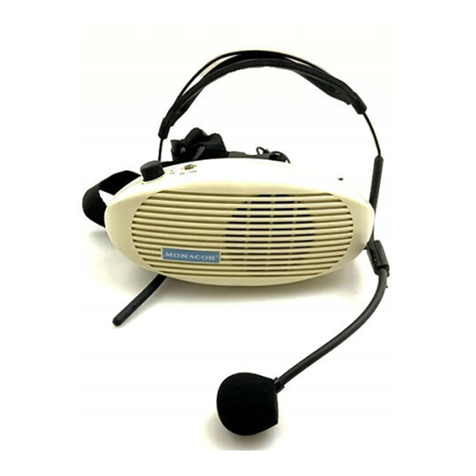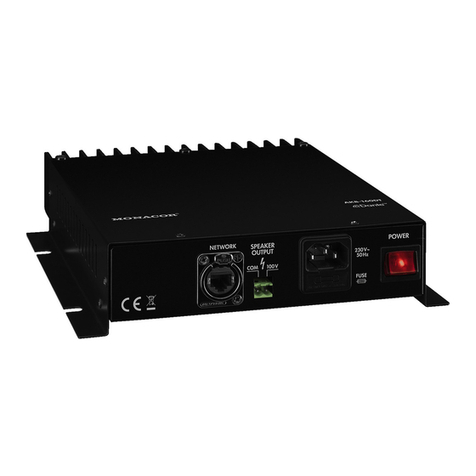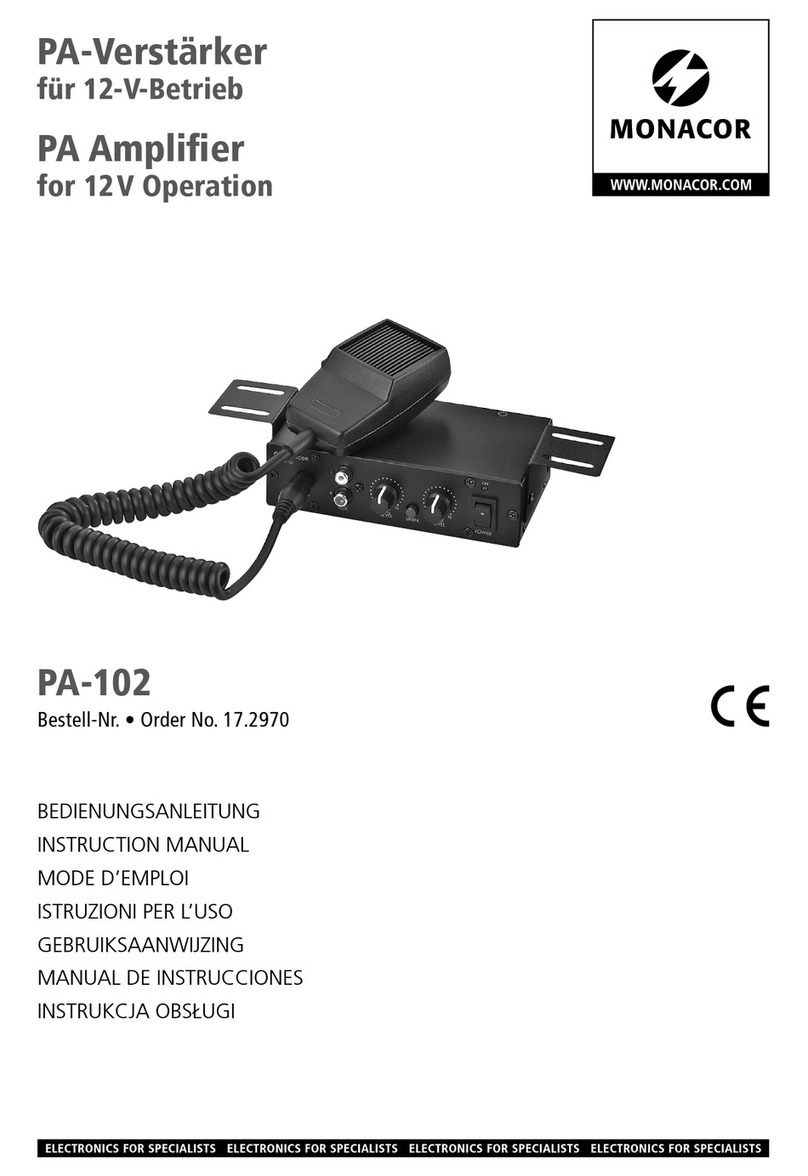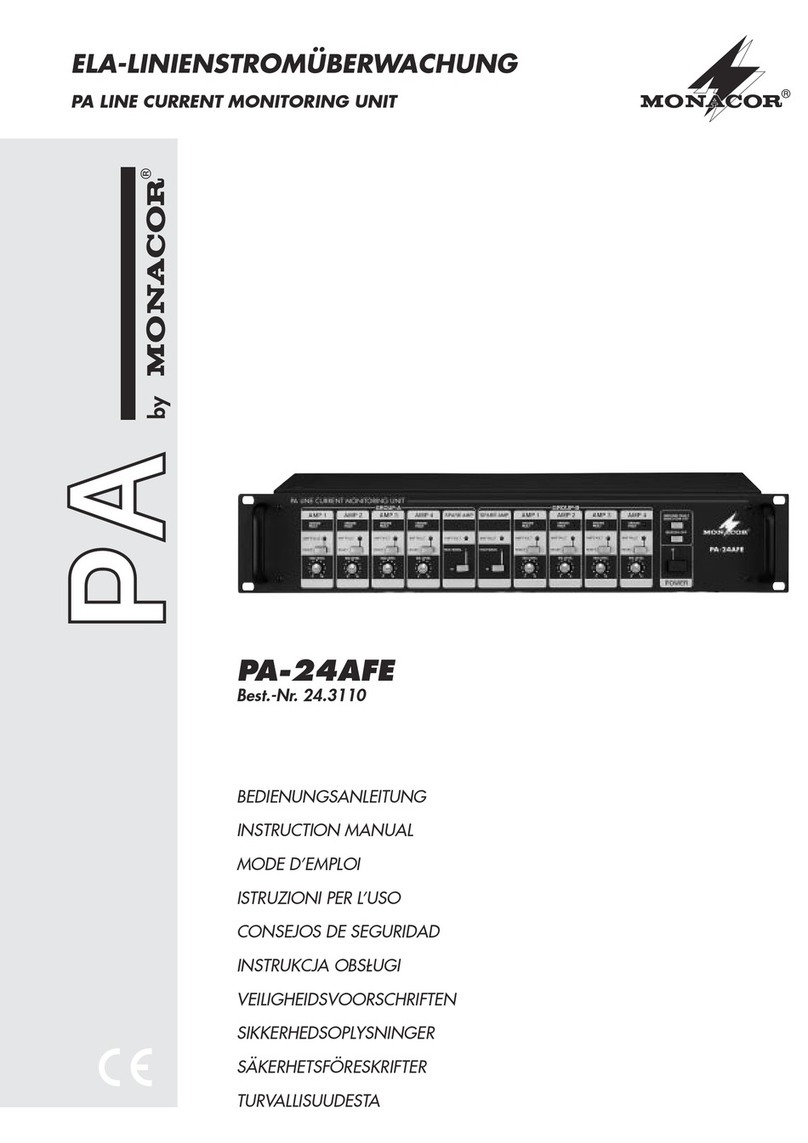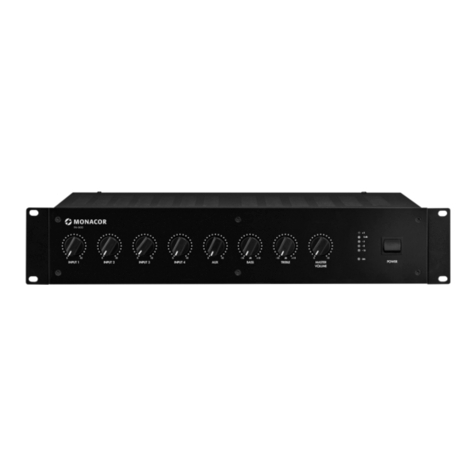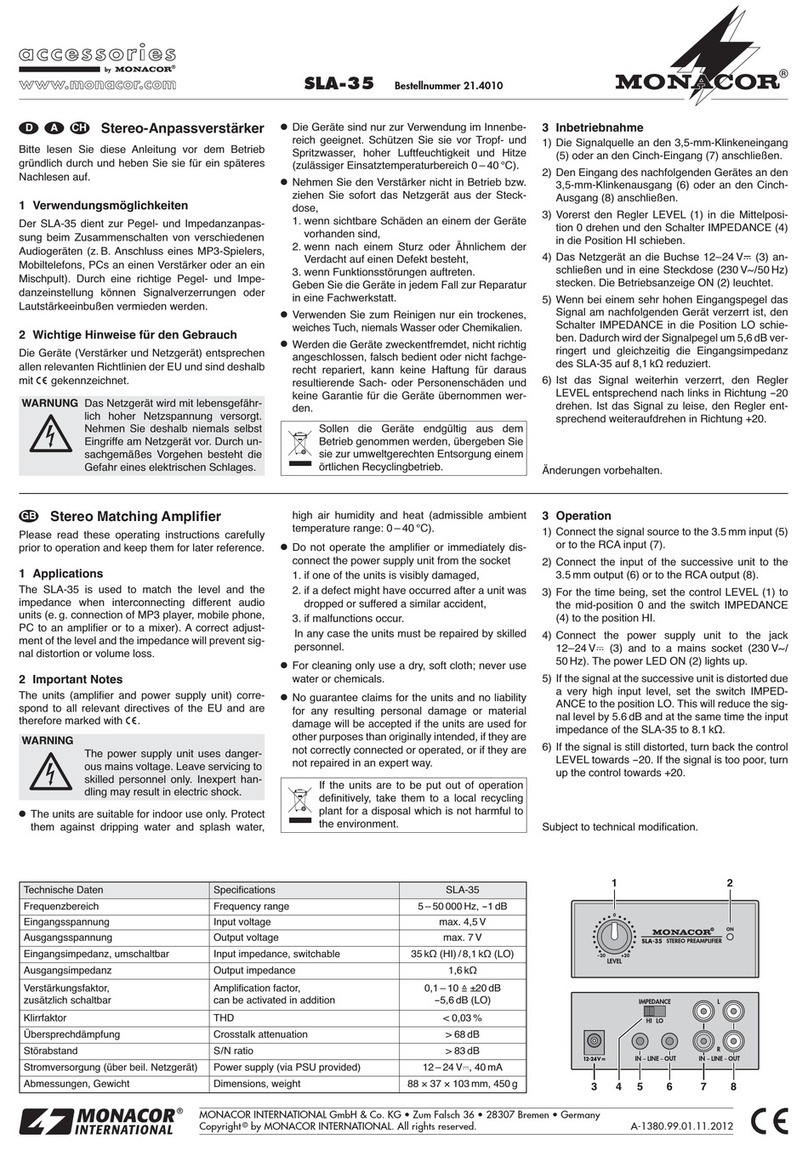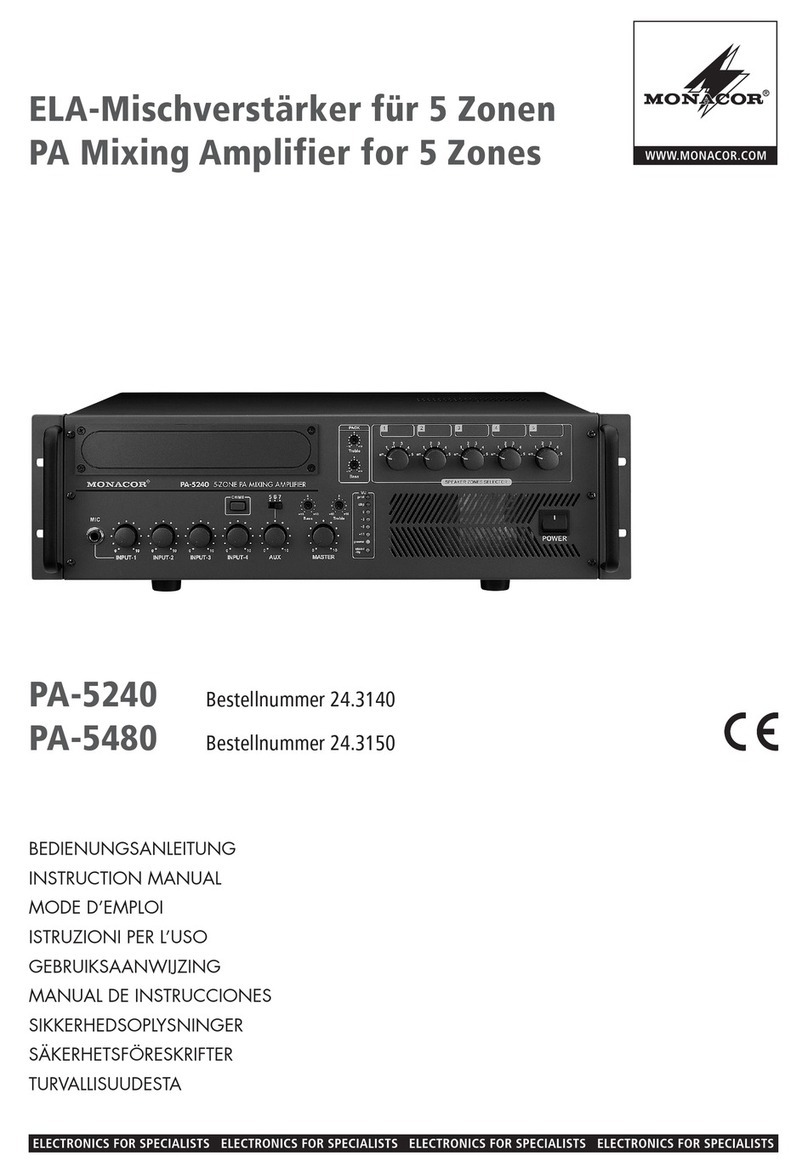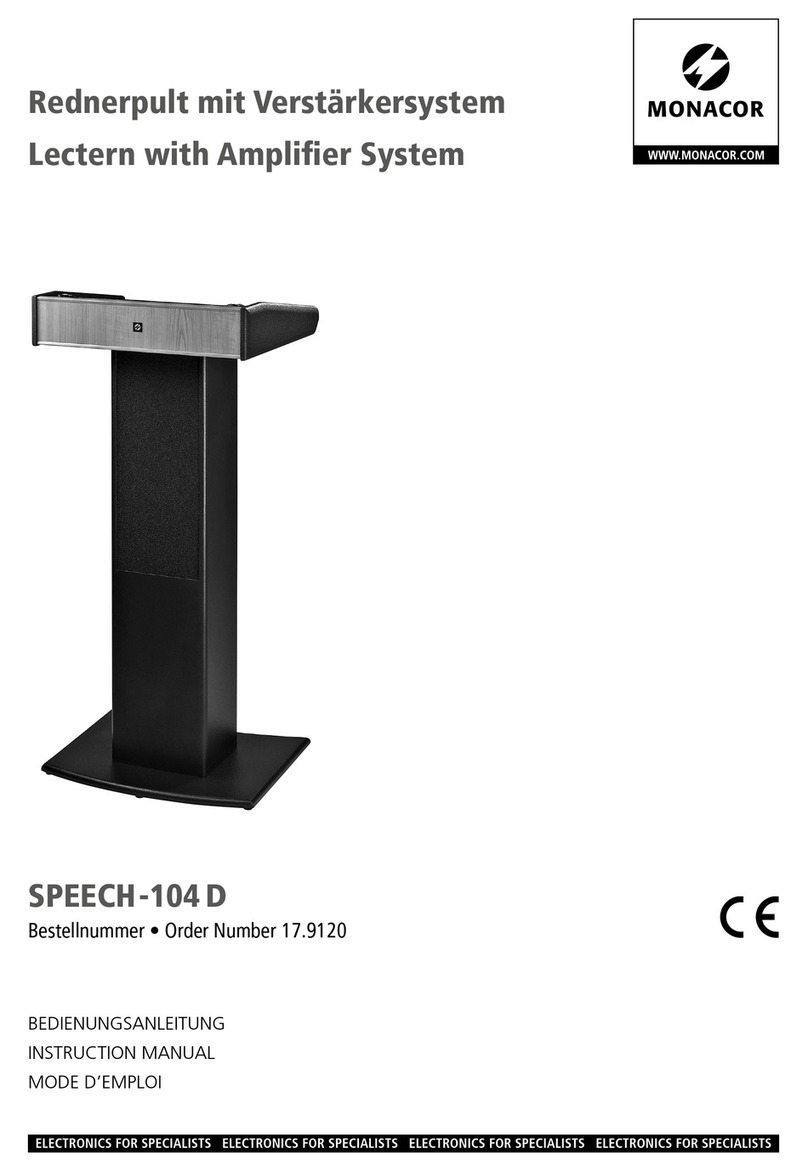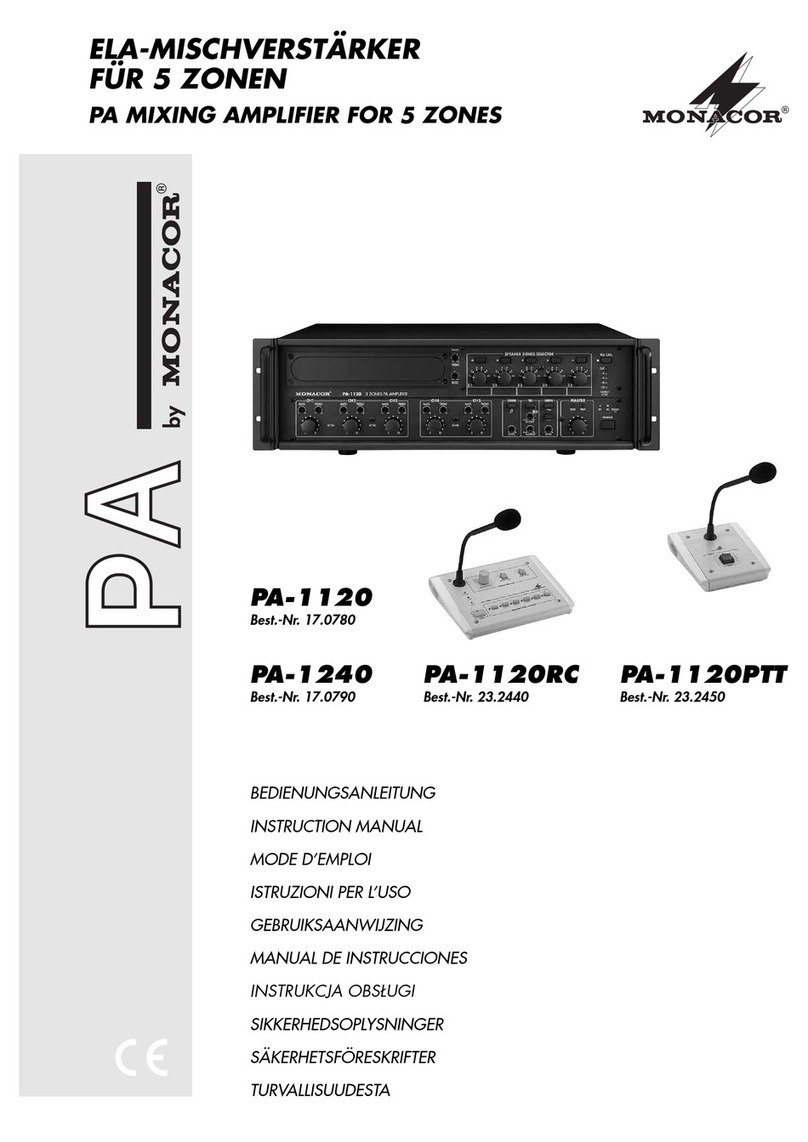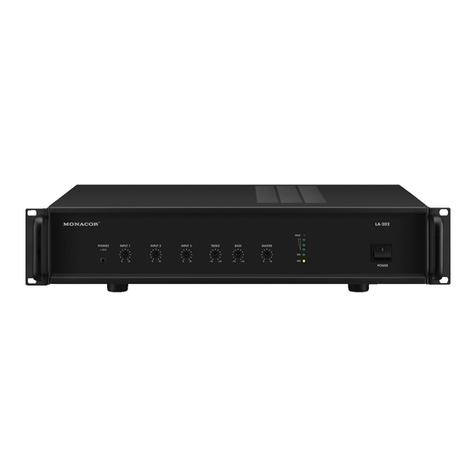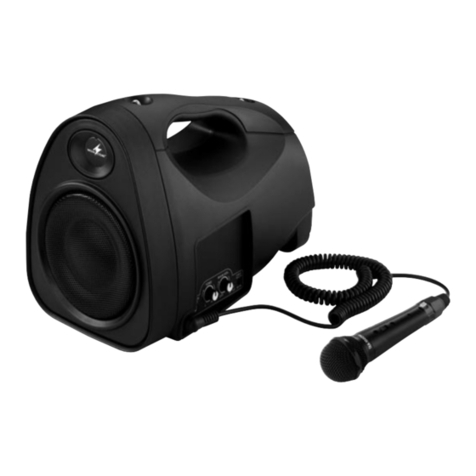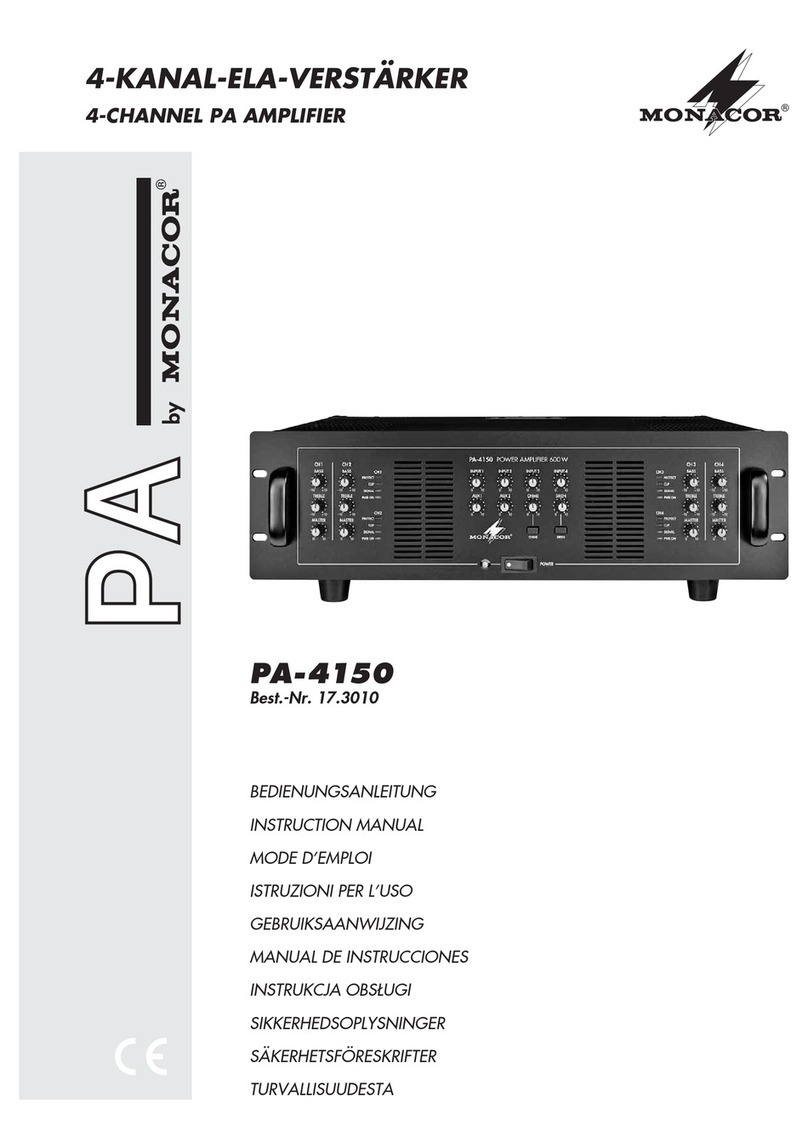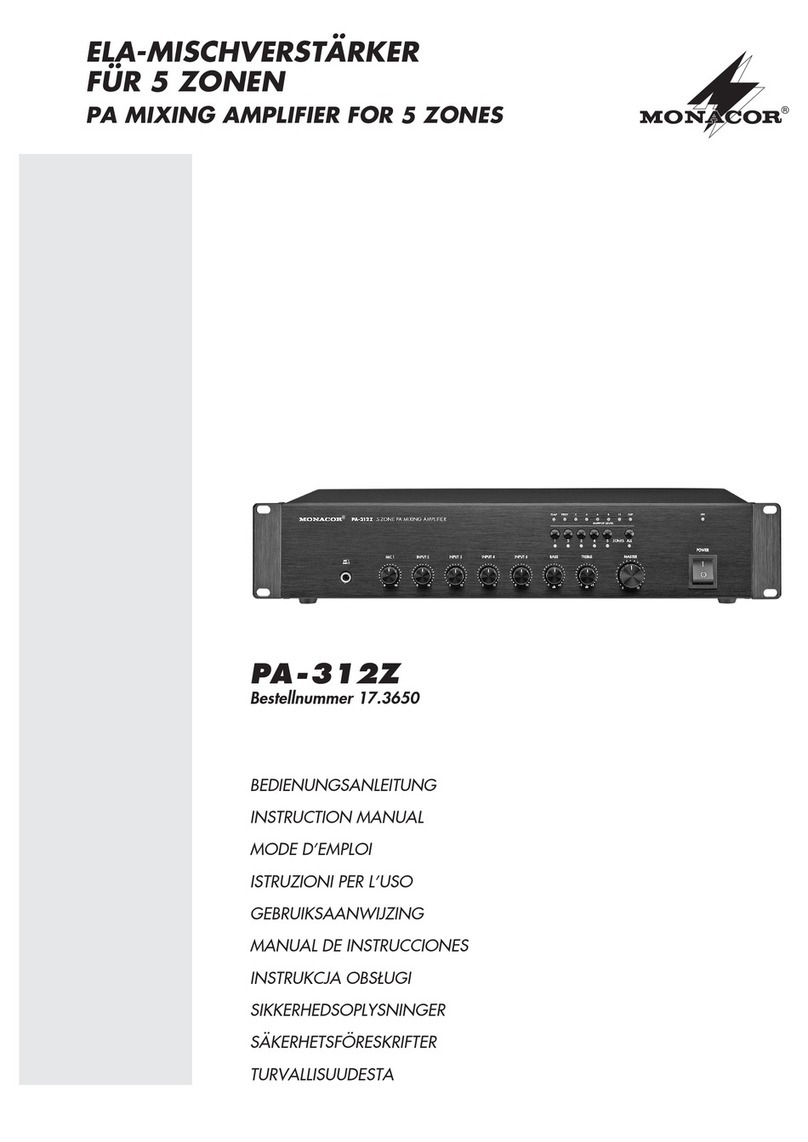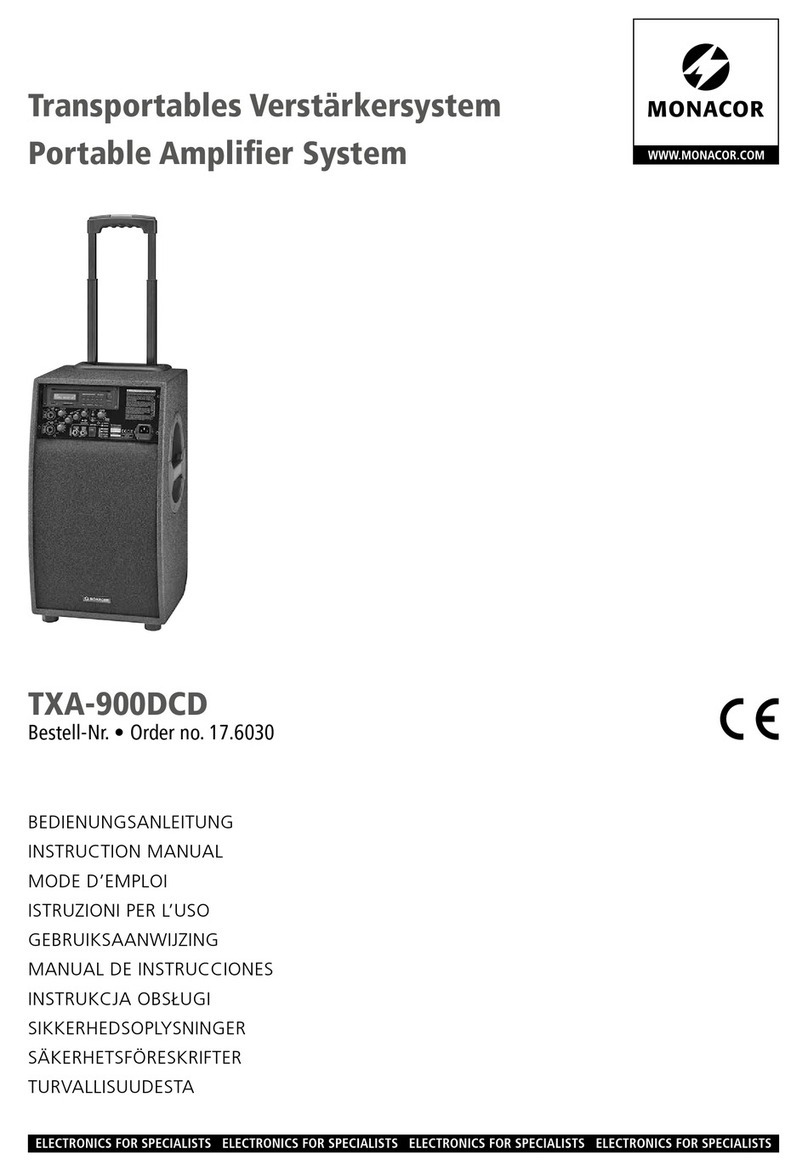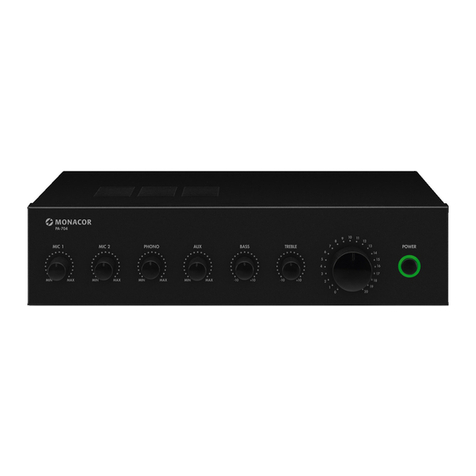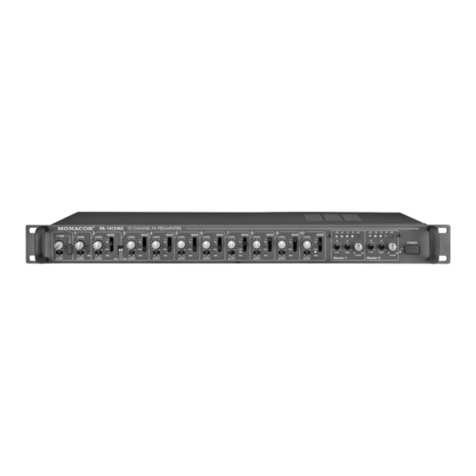GStellen Sie keine mit Flüssigkeit gefüllten Gefäße,
z. B. Trinkgläser, auf das Gerät.
GDie im Gerät entstehende Wärme muss durch
Luftzirkulation abgegeben werden. Decken Sie
die Lüftungsöffnungen nicht ab.
GStecken Sie nichts durch die Lüftungsöffnungen.
Dies kann zu einem elektrischen Schlag führen!
GNehmen Sie das Gerät nicht in Betrieb und ziehen
Sie sofort den Netzstecker aus der Steckdose:
1. wenn sichtbare Schäden am Gerät oder an der
Netzanschlussleitung vorhanden sind,
2. wenn nach einem Sturz oder Ähnlichem der
Verdacht auf einen Defekt besteht,
3. wenn Funktionsstörungen auftreten.
Lassen Sie das Gerät in jedem Fall in einer Fach-
werkstatt reparieren.
GZiehen Sie den Netzstecker nie am Kabel aus der
Steckdose, fassen Sie immer am Stecker an.
GVerwenden Sie zum Reinigen nur ein trockenes,
weiches Tuch, niemals Wasser oder Chemikalien.
GWird das Gerät zweckentfremdet, nicht richtig
angeschlossen, falsch bedient oder nicht fachge-
recht repariert, kann keine Garantie für das Gerät
und keine Haftung für daraus resultierende Sach-
oder Personenschäden übernommen werden.
3 Einsatzmöglichkeiten
Dieser Verstärker mit integriertem CD-Spieler ist
speziell für den Einsatz in ELA-Beschallungsan-
lagen konzipiert. Er kann 120 W Sinus an 100-V-
und 70-V-Lautsprecher abgeben oder an eine Laut-
sprechergruppe mit einer Gesamtimpedanz von
4 Ω. An die fünf miteinander mischbaren Eingangs-
kanäle lassen sich Mikrofone (Kanäle 1 – 4) oder
Geräte mit Line-Pegel (Kanäle 1 – 4 und AUX) an-
schließen. Der Kanal 1 ist mit einer Talkover-Funk-
tion ausgestattet, die bei einer Durchsage die ande-
ren Kanäle in der Lautstärke um 40 dB reduziert.
Der CD-Player ist mit einem Anti-Schock-Spei-
cher ausgestattet, der Störungen beim Abtasten
einer CD durch Stöße und Vibrationen bis 40 Sekun-
den ausgleichen kann. Jedoch können damit keine
lang anhaltenden Störungen ausgeglichen werden.
Zum Testen lässt sich der Anti-Schock-Speicher mit
der Taste ESP (39) ausschalten (nicht bei MP3-
Betrieb). Das Display (7) signalisiert kurz „ESP
OFF“. Zum Wiedereinschalten die Taste ESP erneut
drücken. Das Display zeigt kurz „40 SEC CD“.
4 Aufstellen des Verstärkers
Der Verstärker ist für den Einschub in ein Rack
(482 mm/19") vorgesehen, kann aber auch als
Tischgerät verwendet werden. In jedem Fall muss
Luft ungehindert durch alle Lüftungsöffnungen strö-
men können, damit eine ausreichende Kühlung der
Endstufe gewährleistet ist.
4.1 Rackeinbau
Für den Einbau in ein Rack die beiden mitgelieferten
Montagewinkel an die Geräteseiten anschrauben.
Im Rack werden für den Verstärker 2 Höheneinhei-
ten benötigt (1 Höheneinheit HE = 44,5 mm).
Damit das Rack nicht kopflastig wird, muss der
Verstärker im unteren Bereich des Racks einge-
schoben werden. Für eine sichere Befestigung rei-
chen die Montagewinkel allein nicht aus. Zusätzlich
müssen Seitenschienen oder eine Bodenplatte das
Gerät halten.
5 ELA-Verstärker anschließen
Alle Anschlüsse sollten nur durch eine qualifizierte
Fachkraft und unbedingt bei ausgeschaltetem Ver-
stärker vorgenommen werden!
5.1 Lautsprecher
Es können ELA-Lautsprecher oder Lautsprecher
bzw. Lautsprechergruppen mit einer Gesamtimpe-
danz von mindestens 4 Ω angeschlossen werden.
Die Anschlussmöglichkeiten für die Lautsprecher
sind in den Abb. 4 – 8 dargestellt. Je nach Lautspre-
chertyp die entsprechenden Kontakte der Klemm-
leiste OUTPUT (24) verwenden. Die Klemmleiste
lässt sich zur besseren Handhabung aus ihrer
Steckverbindung herausziehen.
Beim Anschluss auf die richtige Einzel- bzw.
Gesamtimpedanz der Lautsprecher und auf ihre
richtige Polung achten (Plus- und Minusanschlüsse
wie in Abb. 4 – 8 gezeigt). Der Plusanschluss der
Lautsprecher ist immer besonders gekennzeichnet.
5.2 Mikrofone
Bis zu vier Mikrofone lassen sich an die Eingänge
INPUT 1 bis INPUT 4 (25) anschließen. Anstelle der
XLR-Buchse INPUT 1 können auch die Schrauban-
schlüsse (30) verwendet werden.
1) Bei Anschluss eines Mikrofons den dazugehöri-
gen Schalter MIC/LINE (29) ausrasten.
2) Bei Verwendung phantomgespeister Mikrofone
die 21-V-Phantomspannung mit der Taste +21 V
PHANTOM POWER (32) einschalten.
Vorsicht!
Bei zugeschalteter Phantomspannung dürfen an
den Eingängen keine Mikrofone mit asymmetri-
schem Ausgang angeschlossen sein, da diese
beschädigt werden können.
Vorsicht!
Bei ELA-Lautsprechern mit 70-V- oder 100-V-
Audiotransformator (Abb. 4 und 5) darf die Ge-
samtbelastung durch die Lautsprecher nicht mehr
als 120 W Sinus betragen, sonst wird der Verstär-
ker überlastet und eventuell beschädigt.
Soll das Gerät endgültig aus dem Betrieb
genommen werden, übergeben Sie es zur
umweltgerechten Entsorgung einem ört-
lichen Recyclingbetrieb.
GDo not insert anything into the air vents! This
could result in an electric shock!
GDo not set the unit into operation, and immediately
disconnect the mains plug from the mains socket if
1. there is visible damage to the unit or to the
mains cable,
2. a defect might have occurred after a drop or
similar accident,
3. there are malfunctions.
The unit must in any case be repaired by skilled
personnel.
GNever pull the mains cable to disconnect the
mains plug from the mains socket, always seize
the plug.
GFor cleaning only use a dry, soft cloth, by no
means chemicals or water.
GNo guarantee claims for the unit and no liability
for any resulting personal damage or material
damage will be accepted if the unit is used for
other purposes than originally intended, if it is not
correctly connected or operated, or not repaired in
an expert way.
GImportant for U. K. Customers!
The wires in the mains lead of the power supply
unit are coloured in accordance with the following
code:
green/yellow = earth
blue = neutral
brown = live
As the colours of the wires in the mains lead of this
appliance may not correspond with the coloured
markings identifying the terminals in your plug,
proceed as follows:
1.
The wire which is coloured green and yellow must
be connected to the terminal in the plug which is
marked with the letter E or by the earth symbol ,
or coloured green or green and yellow.
2. The wire which is coloured blue must be con-
nected to the terminal which is marked with the
letter N or coloured black.
3. The wire which is coloured brown must be con-
nected to the terminal which is marked with the
letter L or coloured red.
Warning – This appliance must be earthed.
3 Applications
This amplifier with integrated CD player has espe-
cially been designed for use in PA systems. It is able
to supply 120 WRMS to 100 V or 70 V speakers or to
a speaker group with a total impedance of 4 Ω. To
the five input channels which can be mixed with one
another, microphones (channels 1 – 4) or units with
line level (channels 1 – 4 and AUX) can be connect-
ed. Channel 1 is equipped with a talkover function
which attenuates the volume of the other channels
by 40 dB in case of an announcement.
The CD player is equipped with an anti-shock
memory which is able to compensate interruptions
up to 40 seconds caused by shocks and vibrations
when sampling a CD. However, the anti-shock mem-
ory will not be able to compensate continuous inter-
ruptions. For testing, switch off the anti-shock mem-
ory with the button ESP (39) [not during MP3
operation]. The display (7) will shortly indicate “ESP
OFF”. To switch it on again, press the button ESP
again. The display will shortly indicate “40 SEC CD”.
4 Setting up the Amplifier
The amplifier has been designed for installation into
a rack (482 mm/19"), however, it can also be used
as a table top unit. In any case, air must be allowed
to pass through all air vents without obstruction to
ensure sufficient cooling of the power amplifier.
4.1 Rack installation
For rack installation screw the two supplied mounting
brackets to the sides of the unit. For the amplifier
2 rack spaces are required (1 rack space = 44.5 mm).
To prevent top-heaviness of the rack, the ampli-
fier must be inserted into the lower part of the rack.
The mounting brackets alone will not be able to
secure the unit. Side rails or a base plate must addi-
tionally be provided.
5 Connecting the PA Amplifier
All connections should only be made by qualified,
specialized personnel and with the amplifier
switched off in any case!
5.1 Speakers
It is possible to connect PA speakers or speakers/
speaker groups with a total impedance of at least
4 Ω. The possibilities of connection for the speakers
are shown in figures 4 – 8. Depending on the
speaker type, use the corresponding contacts of the
terminal strip OUTPUT (24). To facilitate handling,
the terminal strip can be pulled out of its plug-in con-
nection.
When connecting, observe the correct individual
or total impedance of the speakers and their correct
polarity (positive and negative connections as
shown in figs. 4 – 8). The positive connection of the
speakers is always especially coded.
5.2 Microphones
Up to four microphones may be connected to INPUT 1
to INPUT 4 (25). Instead of the XLR jack INPUT 1 also
the screw terminals (30) may be used.
Caution!
In case of PA speakers with a 70 V or 100 V audio
transformer (figs. 4 and 5), the total load by the
speakers must not exceed 120 WRMS, otherwise the
amplifier will be overloaded and possibly damaged.
If the unit is to be put out of operation defin-
itively, take it to a local recycling plant for a
disposal which is not harmful to the envi-
ronment.
6
GB
D
A
CH
